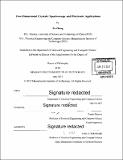Two-dimensional crystals : spectroscopy and electronic applications
Author(s)
Zhang, Xu, Ph. D. Massachusetts Institute of Technology
DownloadFull printable version (21.09Mb)
Other Contributors
Massachusetts Institute of Technology. Department of Electrical Engineering and Computer Science.
Advisor
Tomás Palacios.
Terms of use
Metadata
Show full item recordAbstract
The success in creating atomically thin and mechanically robust two-dimensional (2D) crystals, starting with graphene, has unveiled new possibilities for next generation of ultrafast and ubiquitous electronics. One critical distinction between 2D crystals and 3D crystals is that 2D crystals are all-surface materials. Therefore, it is essential to understand how 2D materials interact with their environments and how this interaction impacts their electronic properties. From a practical perspective, it also provides us with a unique tool to tailor the electronic properties of 2D materials through surface functionalization. In the first half of this thesis, a suite of X-ray techniques is used to investigate how the surface functionalizing dopants will impact the electronic and chemical states of graphene. Based on this study, we develop an effective and non-invasive doping method for graphene through plasma-based chlorination. In order to make system-level 2D electronics successful, a flexible and ubiquitous energy harvesting solution is indispensable. Therefore, the second part of this thesis is dedicated to the development of a MoS₂ 2H-1T phase heterojunction-based GHz flexible rectifier as an enabling component for wireless energy harvester. It is the first flexible rectifier operating up to the X-band and it covers most of the unlicensed industrial, scientific and medical (ISM) radio band, including the Wi-Fi channels. By integrating this rectifier with an antenna, the MoS₂-enabled rectenna successfully demonstrates direct energy harvesting of electromagnetic (EM) radiation in the Wi-Fi band and lights up a commercial light-emitting diode (LED) with zero external bias (battery-free). Moreover, our MoS₂ rectifier also realizes successful frequency conversion as a mixer beyond 10 GHz on flexible substrates. This work provides a universal energy harvesting building block that can be integrated with various wearable electronic systems and paves the way towards using the existing Wi-Fi infrastructure as an energy hotspot for wireless charging.
Description
Thesis: Ph. D., Massachusetts Institute of Technology, Department of Electrical Engineering and Computer Science, 2017. Cataloged from PDF version of thesis. Includes bibliographical references (pages 159-177).
Date issued
2017Department
Massachusetts Institute of Technology. Department of Electrical Engineering and Computer SciencePublisher
Massachusetts Institute of Technology
Keywords
Electrical Engineering and Computer Science.